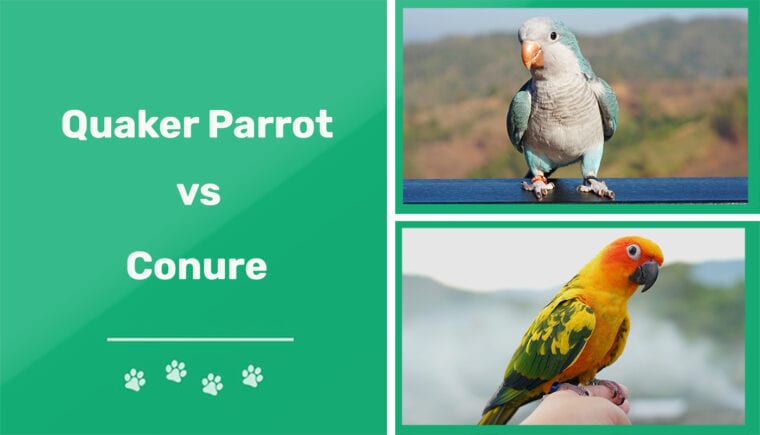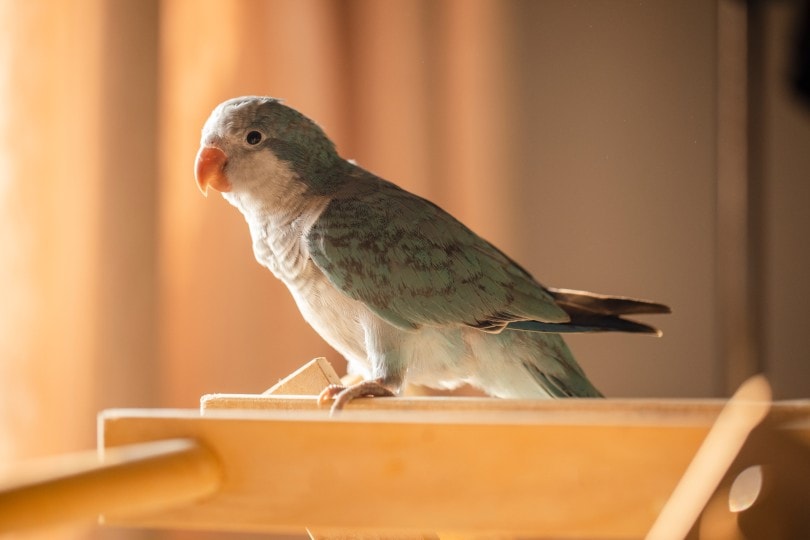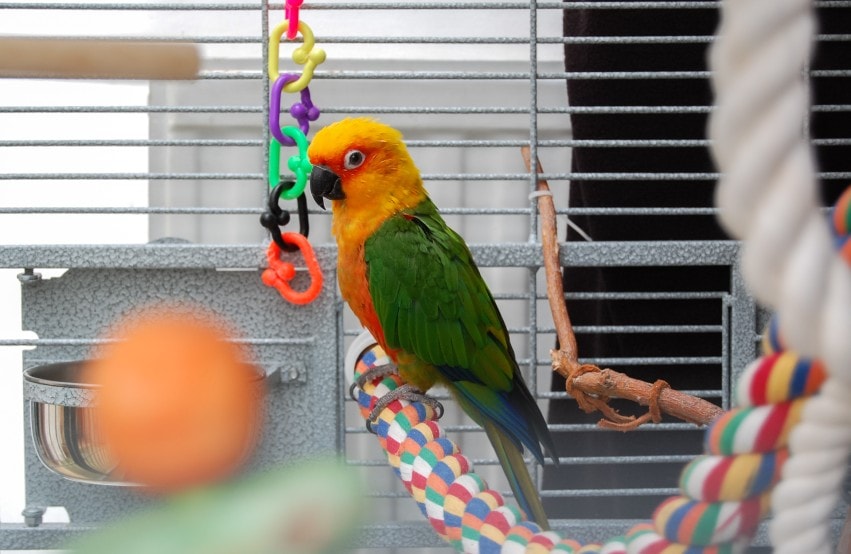
Click to Skip Ahead
Quaker parrots and Conures are similar in many respects. They are both considered good companion birds as well as being found in nature. They both originate from South America, are roughly the same size, and have similar habitat, food, and toy requirements.
Birds of both species may talk, although it isn’t guaranteed. With good socialization, they can both get along with family members and potentially even visitors.
However, the Quaker parrot is easier to obtain and the more likely of these species to talk. Conures, which are considered endangered in the wild, are more difficult to find and they can be very loud, especially when kept in pairs or groups.
Read on to learn more about these two popular companion bird species and to determine which is right for you and your home.
Visual Differences

At a Glance
Quaker Parrot Overview

The Quaker parrot originates from several countries in South America, although a handful of feral colonies have sprung in nearly half the states of the U.S. They even survive in colder climates, taking food from bird feeders in winter and surviving by sleeping in their nests every night.
Also known as the Monk parakeet or Quaker parakeet, they are sociable birds that typically live in woodlands and heavily wooded areas, although they have proven surprisingly adaptable as they have spread into new territories.
The name Quaker parrot, or Quaker parakeet, comes from the natural bobbing and quaking motion of the birds. The alternative name, Monk parakeet, is derived from the fact that their head coloring looks like a monk’s hood.
Personality
Often described as little clowns, Quaker parrots are confident birds. As such, they will integrate well into families, getting along well with all family members, although they may form a stronger bond with a single human family member. It is down to the owner to ensure that the bird is well-socialized and gets along with other humans.
They need as much attention as larger parrot species, so potential owners should be prepared to spend time with their birds and allow them plenty of time out of the cage.
Vocalizations
Capable of developing a very good vocabulary of words, Quaker parrots are known for being likely to mimic human speech. They will also mimic other sounds, including bird song, and they are prone to being quite vocal if you keep multiple Quakers in the same room. For this reason, and because Quakers can get the company they need from humans, some owners choose to keep them as solitary birds.
Training
Developing a strong bond with your Quaker is the first step to effective training. It’s usually also easier to train a single Quaker, rather than a bird that is kept as one of a pair or group. With patience and persistence, it is possible to train a Quaker. Primarily, training means encouraging positive behavior and discouraging negative traits.
The first thing owners usually teach a bird is not to bite. Don’t react to the biting and, instead, divert your bird’s beak to a toy or something they are allowed to chew on. Alternatively, ignore the bite and leave the bird for a few minutes before coming back and giving it more attention.
Quakers can be territorial over their nests, so as well as training your bird not to bite, you will need to get them accustomed to letting you in their area.

Care
Quakers need plenty of space to fly in their cage, with a minimum size being 2 square feet. But a bigger cage will prove even more ideal for this little bird. Quakers are skilled escapologists and strong chewers, so the cage needs to be sturdily built and have a secure door and opening. Provide a birdbath and offer toys as well as a good diet.
Your Quaker needs to be out of the cage for as long as possible each day and 2 hours daily, at the very least. Ensure the room is secure and bear in mind that the brave little Quaker will attempt to take on cats and even dogs in some cases, so you may need to remove other pets from the room.
Conure Overview

Like the Quaker, the conure is native to South America and also prefers woodlands and forests. It is a sociable bird that lives in flocks of up to 20 birds and can be found in larger groups if food is abundant in a particular area. They can also be found in some urban areas, having had to adapt to survive as their natural habitats have become increasingly threatened.
Some species, including the Sun conure, are considered endangered species. Conures are relatively easy to find as pets, although not as commonly found as Quakers.
Personality
Conures are fun birds. They are social and very inquisitive little animals and some of them enjoy cuddling with their owners, although some are too busy to settle down long enough for this level of personal interaction.
The small conure is considered patient with children, which makes the species a good choice for families. They even enjoy being petted on the chest and other areas of the body that large parrot species tend to dislike. They do need socialization and will need training to prevent biting, but they can make very good family pets.
Vocalizations
It is possible to teach some conures to speak a few words, but their vocabulary tends to be limited compared to other species, and some will never mimic human words. The species does have a high-pitched screech that is its natural voice, and most are not afraid to use it, which means you should be prepared for a loud bird if you intend to get a conure.
It may be possible to reduce noise levels by providing plenty of toys and other sources of enrichment, but screeching comes naturally, so, likely, you will never eliminate this noise completely.
Training
It is possible to train a conure, although it will take more patience than with a Quaker. With time, patience, and repetition, you can train a conure to perform basic tricks like stepping onto your hand, waving, or high-fiving.
Use your bird’s favorite treats, encourage the motion, use the same word every time, and praise and reward your bird every time it completes the action. Be consistent and persistent, and it will happen.

Care
A conure needs a similar-sized cage to a Quaker parrot, so around 2-foot squared. It also needs toys and other forms of enrichment, such as ladders and mirrors, as well as a bird bath.
Feed commercial pellets designed specifically for the breed, and add some leafy greens, berries, and other brightly colored fruits and vegetables to give variety and ensure you’re meeting all of your conure’s daily nutritional requirements.
You can also provide a cuttlebone to help maintain good beak health.
How to Get Your Bird to Talk
Like a lot of birds, parrot species replicate or mimic the sounds they hear around them. Where parrot species differ is that they can mimic human words. However, no matter what species of bird, there is no guarantee that any individual bird will learn to mimic human words. Even some African Gray parrots may never repeat human words.
But there are some steps you can take to help improve the likelihood of your conure or Quaker talking.
Time Out of the Cage
Birds like conures and Quaker parrots are social birds. They are used to living on flocks of dozens or even hundreds of birds and they are used to having the freedom to fly around and socialize with the rest of the flock.
When kept as pets, they are kept in cages with much less room than they enjoy in the wild, and even if you keep a pair of birds, they are naturally used to having more opportunities for socialization and investigation. As such, letting your bird have time out of its cage is vital to its mental and physical health, especially if this time includes time spent with you and the rest of its family.
Ensure the room is secure, which may include removing other pets from the room and definitely means checking doors and windows. Open the door and let your bird investigate. If you struggle to get the bird back in its cage, don’t feed it while out of the cage and put food in its bowl. But most birds will get back in the cage willingly in time.
Both the conure and the Quaker parrot need regular time out of the cage, and both require at least two hours a day out of their confines.
Which Breed Is Right for You?
Conure and Quaker parrots both make great companion birds. They’re smaller than the large parrot species and they both enjoy time with their humans, although this does depend on socialization and other factors. Both need time with their humans and time out of their cage, and they both benefit from having some sort of schedule, so neither is a good choice if you have irregular work patterns or can’t commit to letting them have time out of their cage.
Both the conure and the Quaker parrot can mimic human speech, although the Quaker is the more likely of the two species to talk. If you want a talker, the Quaker may be your best option.
They’re both considered friendly birds that get along with humans, too, but the conure is more likely to form bonds with multiple family members and is generally considered more understanding of children, so the conure makes the better pet for large families.
Although the Quaker parrot is generally easier to find in stores and from breeders, both are common enough that they shouldn’t prove too difficult to find. Because of this, and because they are smaller than the likes of African Grays and other large species, they tend to be reasonably priced.
Featured Image Credit: Jida Xu, Shutterstock









